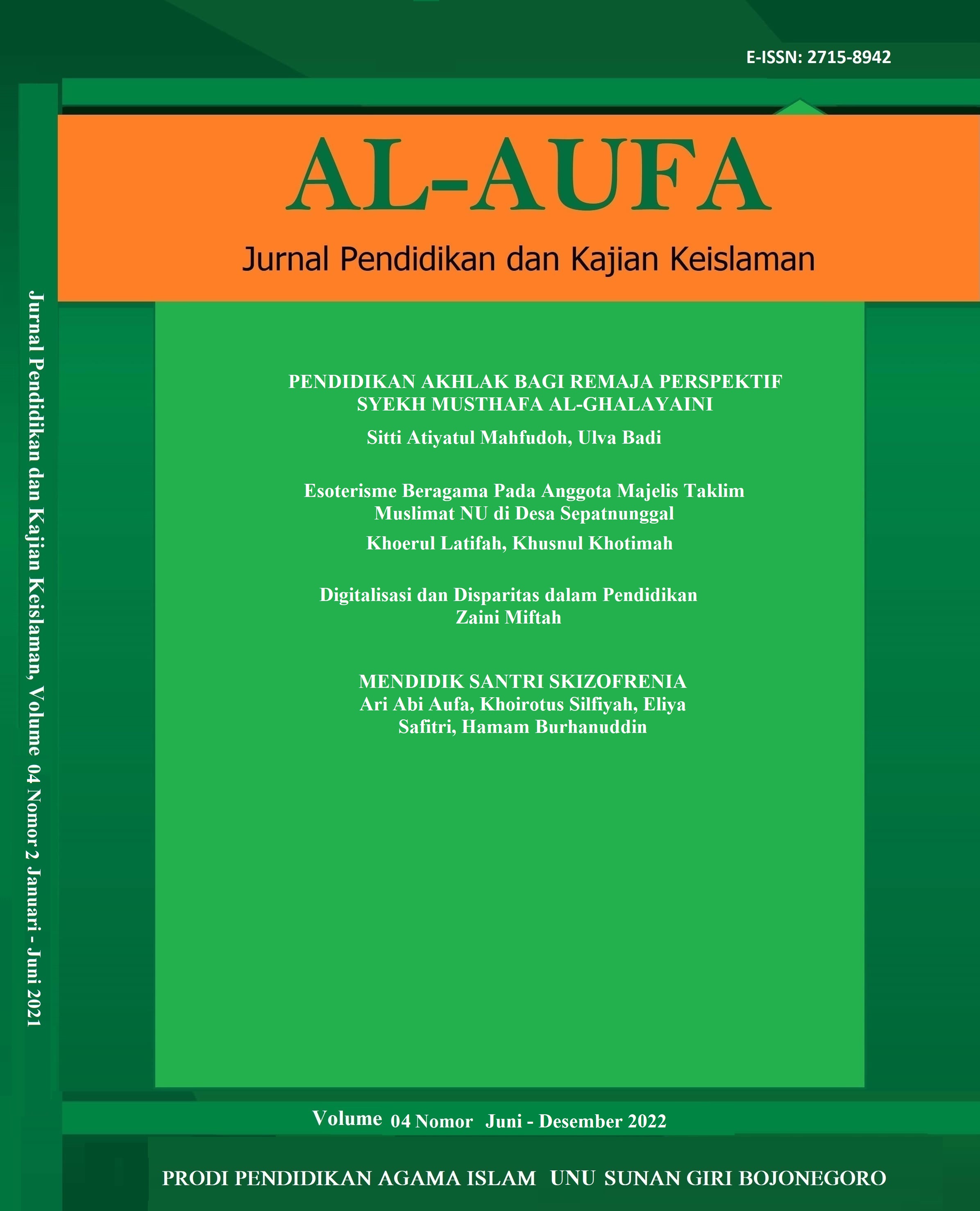Digitalisasi dan Disparitas dalam Pendidikan
Studi Kasus di SDN Ngayung Lamongan
 PDF Download: 226
PDF Download: 226
DOI:
https://doi.org/10.32665/alaufa.v4i2.1572Keywords:
Digitalisasi, Disparitas, pendidikan islamAbstract
Digitalization in education is essentially the government's effort to homogenize access to education and reduce the problem of digital inequality in education. The purpose of this article is to identify aspects of the education digitization policy implemented at Ngayung primary school and the extent to which the digitization policy can help primary school teachers improve access to education and keep up with digitization. The method used in this research is qualitative with a case study approach. The survey respondents in this study were six teachers, the principal, and the SDN supervisor. The data was collected through in-depth interviews and documentation. The survey found that primary school teachers in Ngayung village directly experienced two aspects of the digitization policy in education. The first is the digitization of education policy communication, and the second is the digitization of learning. In the first dimension, teachers experience faster access to education policies. Teachers can better understand national education policies and follow direct instructions from the central government through available information channels. However, for the second aspect, teachers are less prepared in terms of content. They are familiar with media, but they do not use various software products to maximize learning.
References
Adima, M.Z.F. (2021). Sosisalisasi kebijakan pendidikan. MUNTAZAM: Jurnal Manajemen Pendidikan Islam, 2(2), 42-53.
Ariyanti, S. (2016). Studi pengukuran digital divide di Indonesia. Buletin Pos dan Telekomunikasi, 11(4), 281–92.
Arta, I.G.A.J. (2021). Digitalisasi pendidikan: Dilematisasi dan dehumanisasi dalam pembelajaran daring perspektif filsafat Paulo Friere. Pp. 96–107 in Prosiding Seminar Nasional IAHN-TP Palangka Raya.
Azzizah, Y. (2015). Socio-economic factors on Indonesia education disparity. International Education Studies, 8(12), 218–29.
BPPBI. (2016). Kamus Besar Bahasa Indonesia. https://kbbi.kemdikbud.go.id/entri/nilai.
Buwarda, S., Rasyid, K.H., & Hidayat, M. (2020). Fuzzy logic method as determining of internet network VSAT performance in black spot region at District of Enrekang.” P. 12087 in IOP Conference Series: Materials Science and Engineering. Vol. 875. IOP Publishing.
Creswell, J.W. & Cheryl, N.P. (2016). Qualitative inquiry and research design: choosing among five approaches. Sage publications.
Duke, B., Harper, G., & Johnston, M. (2013). Connectivism as a digital age learning theory. The International HETL Review, (Special Issue), 4–13.
Esti, A.D. (2012). Warga Bicara Media: Sepuluh Cerita Cerita. Jakarta: CIPG.
Fuady, A.H. (2019). Teknologi digital dan ketimpangan ekonomi di Indonesia. Masyarakat Indonesia, 44(1), 75–88.
Goldie, J.G.S. (2016). Connectivism: A knowledge learning theory for the digital age?. Medical Teacher, 38(10), 1064–1069.
Händel, M., Stephan, M., Gläser-Zikuda, M., Kopp, B., Bedenlier, S., & Ziegler, A (2020) Digital readiness and its effects on higher education students’ socio-emotional perceptions in the context of the COVID-19 pandemic, Journal of Research on Technology in Education, 54(2), 267-280. DOI: 10.1080/15391523.2020.1846147
Hasan, M., Harahap, T.K. & Inanna. (2021). Landasan Pendidikan. Penerbit Tahta Media Group.
Hermawansyah. (2021). Manajemen lembaga pendidikan sekolah berbasis digitalisasi di era Covid-19. Fitrah: Jurnal Studi Pendidikan, 12(1), 27–46.
Hidayat, A. (2017). Kesenjangan sosial terhadap pendidikan sebagai pengaruh era globalisasi, Justisi Jurnal Ilmu Hukum, 2(1), 15-25.
Joia, L.A. & Lorenzo, M. (2021). Zoom in, zoom out: The impact of the covid-19 Pandemic in the Classroom. Sustainability, 13(5), 25-31.
Julistian, U. (2019). Fasilitasi E-Learning, Kemendikbud Luncurkan Rumah Belajar. Gatra Online. 16 January 2022. https://www.gatra.com/news-456801-teknologi-fasilitasi-e-learning- kemendikbud-luncurkan-rumah-belajar.html.
Kemendikbud. (2011). Apa itu portal Rumah Belajar? Portal Rumah Belajar Kemendikbud. 15 January 2011. https://belajar.kemdikbud.go.id/.
Khidhir, S. (2019). Indonesia is too slow! The ASEAN Post. 16 January 2022, https:// theaseanpost.com/article/indonesia-too-slow.
Miles, M.B. & Huberman, A.M. (1994). Qualitative data analysis: An expanded sourcebook. Sage Publications.
Muhajir, M.A. (2020). Pembelajaran daring di era covid-19: Kesenjangan digital, sistem kompetisi, dan model pendidikan yang manusiawi. MIMIKRI: Jurnal Agama dan Kebudayaan, 6(2), 220-234.
Ott, H., Wang, R., & Bortree, B. (2016). Communicating sustainability online: An examination of corporate, nonprofit, and university websites. Mass Communication and Society, 19(5), 671–87.
Saputra, D.N., Kholil, A., Selegi, S.F., Setia, A., Sinaga, K., & Farisi, A. (2021). Landasan Pendidikan. Media Sains Indonesia.
Setijowati, U., Marjuni, Asih, S.S. & Witanto, Y. (2021). Pemberdayaan guru dan orang tua peserta didik dalam pembelajaran berbasis online. Pp. 224–31 in Standarisasi Pendidikan Sekolah Dasar Menuju Era Human Society 5.0. Cirebon: FKIP Universitas Muhammadiyah Cirebon.
Sinaga, I., Chan, F., & Sofwan, M. (2020). Pemanfaatan Media Pembelajaran Berbasis Teknologi Informasi dan Komunikasi oleh Guru Sekolah Dasar. Edumaspul: Jurnal Pendidikan, 4(1), 271-279. doi.org/10.33487/edumaspul.v4i1.344
Suratman, B., Soesatyo, Y, & Soejoto, A. (2014). Analisis faktor yang memengaruhi ketimpangan pendidikan. Jurnal Ilmu Pendidikan, 20(2), 176-182.
Suryadi, A, Darmawan, D., Rahadian, D., Wahyudin, D., & Riyana, C. (2022). Pengembangan aplikasi sistem database Virtual Community Digital Learning Nusantara (VCDLN) menggunakan model waterfall dan pemrograman terstruktur. Jurnal PETIK, 8(1), 48-56.
Suryana, C. (2021. Komunikasi kebijakan pendidikan. Surabaya: Jakad Media Publishing.
Sutiarso, S. (2020). Optimalisasi penggunaan papan tulis dalam meningkatkan hasil belajar siswa. Seminar Nasional Pendidikan FKIP Unila 2020, Tema: Pembelajaran Abad 21: Mencapai Kompetensi Pendidikan Generasi Emas 2045, 1–5.
Usman, S. (2021). Inklusi sosial di era digital (social inclusion in the digital age). Academic Essay: Diigtal Society. 16 January 2021. https://pssat.ugm.ac.id/inklusi-sosial-di-era- digital-social-inclusion-in-the-digital-age/.
Yanti, M.T., Kuntarto, E., & Kurniawan, A.R. (2020). Pemanfaatan portal Rumah Belajar Kemendikbud sebagai model pembelajaran daring di sekolah dasar. Adi Widya: Jurnal Pendidikan Dasar, 5(1), 61–68.Top of Form
Downloads
Published
How to Cite
Issue
Section
License
Copyright (c) 2022 Zaini Miftah

This work is licensed under a Creative Commons Attribution 4.0 International License.
 PDF Download: 226
PDF Download: 226








